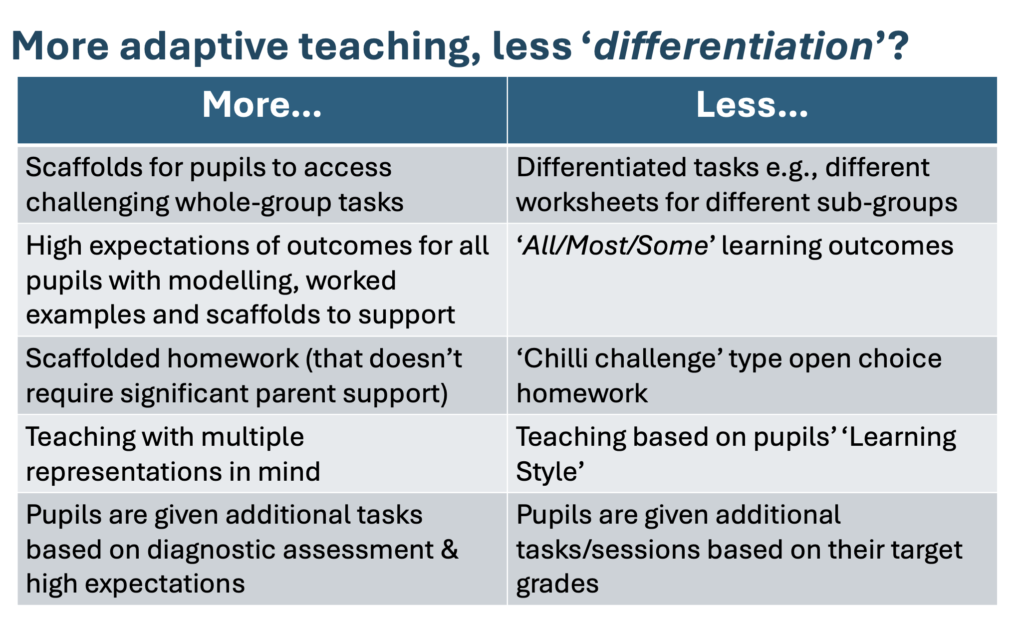Adaptive teaching may be tricky to define, but we must define it well, and exemplify it, otherwise it will prove an empty buzzword.
I’ve tried to characterise it into broadly two types of adaptations:
- Microadaptations (Corno, 2008). Sensitive, moment-to-moment adaptations responding to pupils’ learning e.g. deploying flexible grouping in a history lesson to quickly reexplain how they might more effectively plan their essay on Scrooge.
- Significant adaptations. Pupils with a learning difficulty or disability may require significant adaptations and schools are required to ensure reasonable adjustments are made e.g., offering additional Teaching Assistant support with complex tasks. (these can be concurrently described as ‘reasonable adjustments’ when supporting pupils with SEND).
It is helpful to have examples of adaptive teaching, but also to present ‘non-examples’ of what it isn’t too. This is where ‘differentiation’ comes in: the forerunner to the more recently popular adaptive teaching. In training I do on adaptive teaching, I call for more of it and less differentiation (or at least the dubious practices spread in its name):

In a brilliant recent blog, entitled ‘Adaptive teaching: The Four Verbs Approach’, Clare Sealy has done an excellent job in breaking down and exemplifying approaches that can be characterised as adaptive teaching. It is so useful because she defines some of the variables that teachers must consider when setting tasks that challenge all pupils. Sealy describes the following four principles for adaptive teaching by design:
- Having to think about more things
- The intrinsic demands of the content
- How much external support for memory demands is provided
- How much the learner knows.
Differentiation by task is one of the challenging areas that we need to leave behind. If we are setting simple tasks for struggling pupils, but complex tasks for high prior attainers, how are they ever meant to catch up. As Sealy describes, “being given different work [should] become rare rather than routine”. Instead, we can approach planning lesson tasks with the above principles and high expectations that every pupil can navigate the challenge with support.
Scaffolds, Scale, Structure and Style
It is important, if we are trying to help teachers move on from differentiation, to be clear how tasks can be adapted whilst retaining the same challenging goal. The 4 Ss of ‘scaffolds, scale, and style’ could helpfully define adaptations of a core classroom task every pupil undertakes.
Let’s take the common task of the self-portrait in art. Both in primary school, and particularly in many year 7 classes, working on a self-portrait is a common way to learn art. Of course, lots of pupils have varying starting points. Difficulty is relative. Some pupils who may struggle can begin with the scaffold of a tracing outline, or a basic template to start (scaffolds). Additionally, some pupils may increase the degree of challenge by increasing the scale of the portrait (scale). Equally, some pupils could take a more challenging style, such as using the medium of watercolour paint for their self-portrait (style).
The above task alterations ensures that every pupil accesses the same challenging task. It also addresses Sealy’s verbs, or principles. Templates adjusts ‘external support for memory demands’, whereas a larger scale can increase the ‘intrinsic demand’ of the task.
In English, narrative writing tasks can be adjusted to encompass ‘Scaffolds, scale, and style’. Pupils can be supported with planning frame, sentence starters, phrase banks, style prompts, and much more (scaffolds). The task can vary in length (scale), although pupils can naively mistake the notion that ‘shorter is easier’. Pupils can be given a specific narrative structure to follow, or be expected to make unique choices independent of any style models (structure). To adjust the degree of challenge, pupils may be prompted to imitate an author, reverse a style, or similar (style).
Writing an evaluative essay in religious studies on attitudes to artificial contraception can equally be adapted with ‘scaffolds, scale, and style’ in mind. Pupils can be given an essay structure prompt (scaffolds) or choose to write with more independent planning. We can pose additional sentence signposts for them to use (scaffolds and structure), and so on.
If we explicit with pupils, they can begin to make independent choices about adapting tasks. We can offer scaffolds and scale and style choices, making explicit to them the varying complexities of a given task. By using the 4 Ss explicitly it could encourage self-regulation and even a greater understand of curriculum tasks. Instead of the ‘Chilli challenge’ type approach, or ‘All/Most/Some’ some tasks, there is no race to the bottom of picking the easiest task. Instead, pupils choose the supports to scaffold them to the top.
The 4 Ss model is unlikely to perfectly match every task in the school curriculum, but it may be a helpful heuristic so that teachers can move away from planning different tasks to instead adapt with greater confidence.
[Image via Creative Commons licence – Preply.com Images: https://www.flickr.com/photos/194356589@N04/51701952903]






Comments